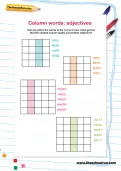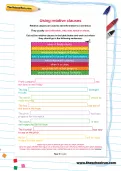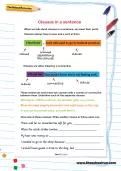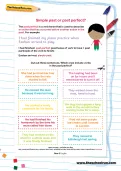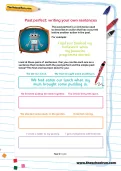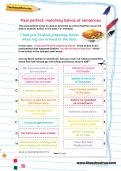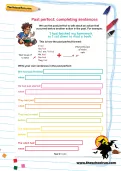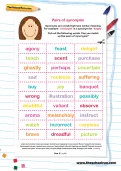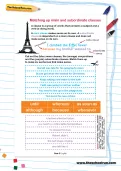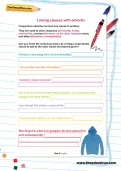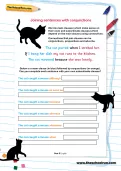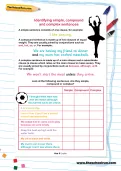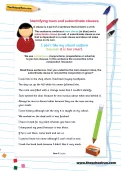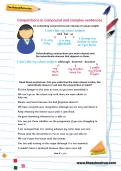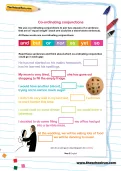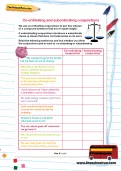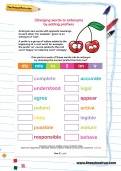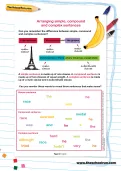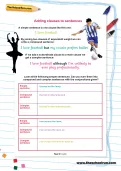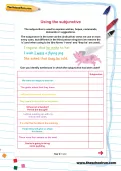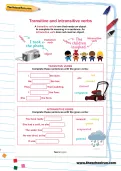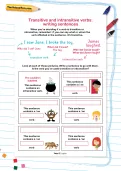The past perfect is a verb tense that is used to describe an action that has occurred before another action in the past. Cut out these sentences. Which ones include verbs in the past perfect?
or
Register to add to your saved resources
Already a subscriber? to view this content.
The past perfect is a verb tense used to describe an action that has occurred before another action in the past. Look at these pairs of sentences. Can you rewrite each one as a sentence that contains both the past perfect and the simple past tense?
or
Register to add to your saved resources
Already a subscriber? to view this content.
The past perfect tense is used to describe an action that has occurred before another action in the past. Cut out these halves of sentences. Can you work out which past perfect tense first half should go with which past tense second half?
or
Register to add to your saved resources
Already a subscriber? to view this content.
We use the past perfect to talk about an action that occurred before another action in the past. Can you write your own sentences in the past perfect?
or
Register to add to your saved resources
Already a subscriber? to view this content.
Synonyms are words that have similar meaning. For example: ‘overjoyed’ is a synonym for ‘happy’. Cut out the following words. Can you match up the pairs of synonyms?
or
Register to add to your saved resources
Already a subscriber? to view this content.
A clause is a group of words that contains a subject and a verb (a doing word). A main clause makes sense on its own. A subordinate clause is dependent on a main clause and does not make sense on its own. Cut out the (blue) main clauses, the (orange) conjunctions and the (purple) subordinate clauses. Match them up to make six sentences that make sense.
or
Register to add to your saved resources
Already a subscriber? to view this content.
Conjunctive adverbs connect one clause to another. They are used to show sequence (eventually, finally,meanwhile), contrast (however, on the other hand) or cause and effect (therefore, subsequently). Can you finish the sentences below by writing a subordinate clause to add to the main clause and adverb given?
or
Register to add to your saved resources
Already a subscriber? to view this content.
We link main clauses (which make sense on their own) and subordinate clauses (which depend on the main clause) using connectives. Connectives that join clauses can be conjunctions, prepositions and adverbs. Below is a main clause (in blue) followed by conjunctions (in orange). Can you complete each sentence with your own subordinate clauses?
or
Register to add to your saved resources
Already a subscriber? to view this content.
Can you identify if these sentences are simple, compound or complex?
or
Register to add to your saved resources
Already a subscriber? to view this content.
Verb tenses tell us when an action took place. The past perfect tense is used to describe an action that has occurred before another action in the past. Look at the following sentences. Can you underline the verbs that are in the past perfect?
or
Register to add to your saved resources
Already a subscriber? to view this content.
A clause is a part of a sentence that contains a verb. A subordinate clause is one that is dependent on a main clause and does not make sense on its own. We use connectives to join two clauses. Read these sentences. Can you underline the main clause in blue, the subordinate clause in red and the conjunction in green?
or
Register to add to your saved resources
Already a subscriber? to view this content.
Co-ordinating conjunctions join clauses of equal weight. Subordinating conjunctions join main clauses and the subordinate clauses that depend on them. Read these sentences. Can you underline the main clause in blue, the subordinate clause in red and the conjunction in black?
or
Register to add to your saved resources
Already a subscriber? to view this content.
We use co-ordinating conjunctions to join two clauses of a sentence that are of ‘equal weight’ (each one could be a stand-alone sentence). Read these sentences and think about which co-ordinating conjunction could go in each gap.
or
Register to add to your saved resources
Already a subscriber? to view this content.
We use co-ordinating conjunctions to join two clauses of a compound sentence that are of equal weight. A subordinating conjunction introduces a subordinate clause (a clause that does not make sense on its own). Read the following sentences and tick whether you think the conjunction used in each is co-ordinating or subordinating
or
Register to add to your saved resources
Already a subscriber? to view this content.
Antonyms are words with opposite meanings to each other. For example, ‘good’ is an antonym of ‘bad’. A prefix is a group of letters added to the beginning of a root word; for example,
the prefix ‘un’ can be added to the root word ‘happy’ to make the word ‘unhappy’. Can you turn each of these words into its antonym by choosing the correct prefix from this row?
or
Register to add to your saved resources
Already a subscriber? to view this content.
A simple sentence is made up of one clause. A compound sentence is made up of two clauses of equal weight. A complex sentence is made up of a main clause and a subordinate clause. Can you reorder these words to reveal three sentences that make sense?
or
Register to add to your saved resources
Already a subscriber? to view this content.
Look at the following simple sentences. Can you turn them into compound and complex sentences with the conjunctions given?
or
Register to add to your saved resources
Already a subscriber? to view this content.
The subjunctive is used to express wishes, hopes, commands, demands or suggestions. The subjunctive is the same as the (indicative) verbs we use in most every case, but different in the third person singular (we remove the ‘s’) and when using to be (the forms ‘I were’ and ‘they be’ are used). Can you identify sentences in which the subjunctive has been used?
or
Register to add to your saved resources
Already a subscriber? to view this content.
A transitive verb is one that needs an object to complete its meaning in a sentence. An intransitive verb does not need an object. Complete these sentences with the given verbs.
or
Register to add to your saved resources
Already a subscriber? to view this content.
When you’re deciding if a verb is transitive or intransitive, remember: if you can say what or whom the verb affected in the sentence, it’s transitive. Look at each of these pictures. Write a sentence to go with them. Is the verb you’ve used transitive or intransitive?
or
Register to add to your saved resources
Already a subscriber? to view this content.

